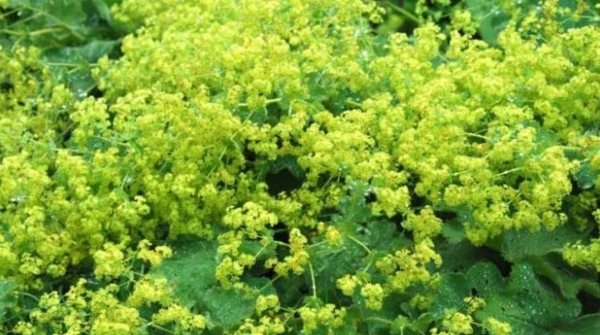
Lady’s Mantle
Botanical Name
:
Alchemilla mollis or Alchemilla vulgaris
Plant Type
:
Perennial, ground cover
Seasons
:
Spring, Summer, Fall (Dormant in winter)
Sun Level
:
Full sun to partial shade. Best with morning sun and afternoon shade in hot climates.
Ideal Soil Temperature for Planting
:
Not picky
Soil Type
:
Moist, well-drained, loamy, or sandy soil rich in organic matter. Tolerates most soils except boggy ground.
Germination
:
Typically propagated by division or self-seeding; seed germination is slow.
P.H. Level
:
Slightly acidic to neutral (5.5–7.5)
Water/Irrigation
:
Drought-tolerant once established but prefers consistent moisture levels, avoid waterlogging. Water regularly during high heat or dry seasons.
Fertilization
:
Rarely necessary unless the soil is poor. Use slow-release organic fertilizer if needed.
Habit
:
Mounding, low-growing, spreading
Final Plant Height
:
12–18 inches (30–45 cm)
Spread
:
18–24 inches (45–60 cm)
Spacing
:
12–24 inches apart for best coverage
Flowers
:
Clusters of small, yellow-green, star-shaped flowers in late spring to early summer.
Attracts
:
Bees, butterflies, and other pollinators.
Uses
:
Borders, cottage gardens, ground cover, edging, cut flowers, floral arrangements
Companions
:
Roses, geraniums, lavenders, irises
Pruning
:
Cut back after flowering to encourage fresh foliage; trim dead leaves in early spring.
Toxicity
:
Non-toxic to humans and pets
Pests
:
Generally pest-free but may occasionally attract aphids or slugs.
Diseases
:
Resistant to most diseases but can develop powdery mildew or leaf spot in humid conditions.
Fun Fact
:
The plant’s Latin name Alchemilla comes from “alchemy” because medieval herbalists believed dew collected from the leaves had magical healing properties.
Additional Info
:
Lady’s Mantle was historically used as a medicinal herb for wound healing, menstrual relief, and skin treatments.
Botanical Name
:
Alchemilla mollis or Alchemilla vulgaris
Plant Type
:
Perennial, ground cover
Seasons
:
Spring, Summer, Fall (Dormant in winter)
Sun Level
:
Full sun to partial shade. Best with morning sun and afternoon shade in hot climates.
Ideal Soil Temperature for Planting
:
Not picky
Soil Type
:
Moist, well-drained, loamy, or sandy soil rich in organic matter. Tolerates most soils except boggy ground.
Germination
:
Typically propagated by division or self-seeding; seed germination is slow.
P.H. Level
:
Slightly acidic to neutral (5.5–7.5)
Water/Irrigation
:
Drought-tolerant once established but prefers consistent moisture levels, avoid waterlogging. Water regularly during high heat or dry seasons.
Fertilization
:
Rarely necessary unless the soil is poor. Use slow-release organic fertilizer if needed.
Habit
:
Mounding, low-growing, spreading
Final Plant Height
:
12–18 inches (30–45 cm)
Spread
:
18–24 inches (45–60 cm)
Spacing
:
12–24 inches apart for best coverage
Flowers
:
Clusters of small, yellow-green, star-shaped flowers in late spring to early summer.
Attracts
:
Bees, butterflies, and other pollinators.
Uses
:
Borders, cottage gardens, ground cover, edging, cut flowers, floral arrangements
Companions
:
Roses, geraniums, lavenders, irises
Pruning
:
Cut back after flowering to encourage fresh foliage; trim dead leaves in early spring.
Toxicity
:
Non-toxic to humans and pets
Pests
:
Generally pest-free but may occasionally attract aphids or slugs.
Diseases
:
Resistant to most diseases but can develop powdery mildew or leaf spot in humid conditions.
Fun Fact
:
The plant’s Latin name Alchemilla comes from “alchemy” because medieval herbalists believed dew collected from the leaves had magical healing properties.
Additional Info
:
Lady’s Mantle was historically used as a medicinal herb for wound healing, menstrual relief, and skin treatments.
Written by Salome Wapukha – https://www.linkedin.com/in/salome-wapukha-556700193/

